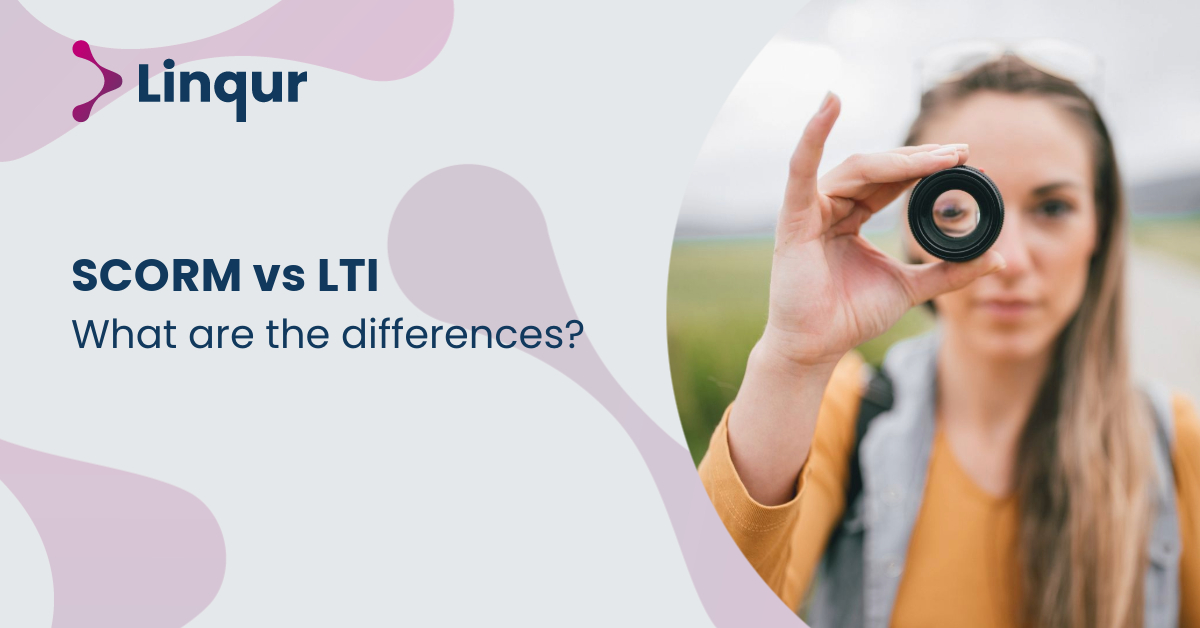Whether you’re a course creator developing your own e-learning materials or an L&D professional looking to integrate external learning content into your LMS, you’ve probably encountered the terms LTI and SCORM. If you’re not entirely sure what these acronyms mean, it’s easy to confuse them. But not anymore! In this blog, we’ll dive into everything you need to know about these e-learning standards. Beyond just definitions, you’ll also learn how to use LTI and SCORM in practice and understand their differences.

Learning Tools Interoperability (LTI) is a technical standard developed by 1EdTech. LTI allows you to seamlessly connect different online (external) learning tools to a single central learning environment without the hassle of separate logins or platforms. It ensures everything is accessible in one place, making it easier for both employers and employees to work with various external providers within their existing learning environment.
For course creators and organizations with learning platforms, LTI enables the seamless integration of external content into onboarding programs, learning pathways, or compliance training. But what does this look like in practice?
LTI for Course Creators
Let’s say your organization develops high-quality courses for financial professionals, such as continuing education (CE) training. With an LTI integration, your client can offer your course directly through their LMS. Participants simply click on the course in their LMS, and everything runs smoothly, including progress tracking and certification. You maintain control over the content and updates, while your client doesn’t have to worry about technical settings.
Want to learn more about LTI? Check out our blog: “What is LTI and What Are Its Benefits?”
LTI for L&D Professionals
With LTI, you can integrate various external tools and learning platforms into your LMS. This means employees can access dynamic, up-to-date content from multiple providers directly within their learning environment, without needing extra logins or switching platforms.
SCORM stands for Sharable Content Object Reference Model, a technical standard used for creating and managing e-learning modules. E-learning developers use authoring tools like Articulate Storyline or Adobe Captivate to create SCORM-compliant modules. SCORM ensures that online learning content works seamlessly within a Learning Management System (LMS).
Think of SCORM as a universal adapter for e-learning. Just as a universal adapter lets you charge devices in any country, SCORM allows e-learning content to be used in any LMS without modifications.
SCORM for Course Creators
You’ve developed an e-learning module on compliance for HR professionals and want to offer it to your clients as a SCORM package. They upload the file into their LMS, and their employees complete the training directly in the system. If you need to update the module later, you send a new SCORM package that must be re-uploaded. This is a great solution for stable courses that don’t require frequent updates.
Want to know more about SCORM? Read our blog: “The Standard in E-Learning: What Is SCORM?”
SCORM for L&D Professionals
You’ve purchased a series of compliance training modules from an external provider. They supply these modules as SCORM packages, which you can easily upload into your organization’s LMS. Employees complete the modules within the LMS, and their progress is automatically tracked. You can monitor completion rates through reports, making SCORM ideal for standardized training programs that remain within your LMS.
While SCORM and LTI both help streamline e-learning, they work differently and have distinct advantages. Here’s an overview, highlighting specific considerations for course creators and L&D professionals.
Cas van Lier is our textual ace, in other words: our copywriter. He ensures that the essence of Linqur is conveyed as effectively as possible through fresh and convincing content. When Cas isn’t at the keyboard, he’s often found at the beach or in the woods with his girlfriend and dog.
With our LTI Provider Service, you can integrate your content into any LMS. Fast, simple, and hassle-free. Get the brochure and find out how!
With SCORM Proxy, you can play SCORM courses in any LMS without worrying about updates or hosting. Sounds good? Request the brochure!
Our LTI Converter transforms SCORM into LTI, making your content work in any LMS. Want to know how? Download the brochure and find out for yourself!
With Magic Link Login, your users log in securely with just one click – no passwords, no hassle. Discover how in the brochure!
With the Linqur API, you can seamlessly connect e-learning systems and automate everything. Download the brochure and discover the benefits.